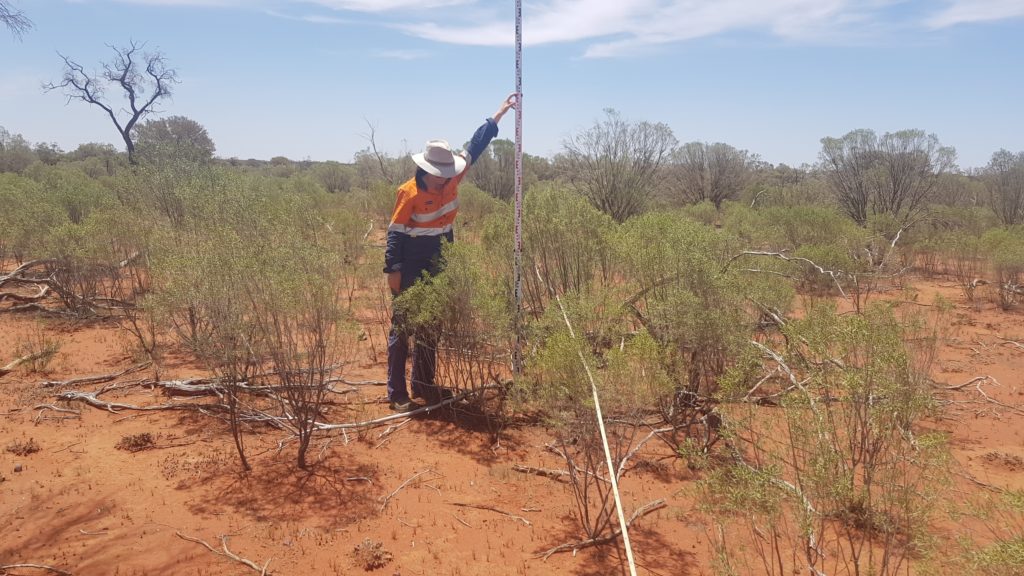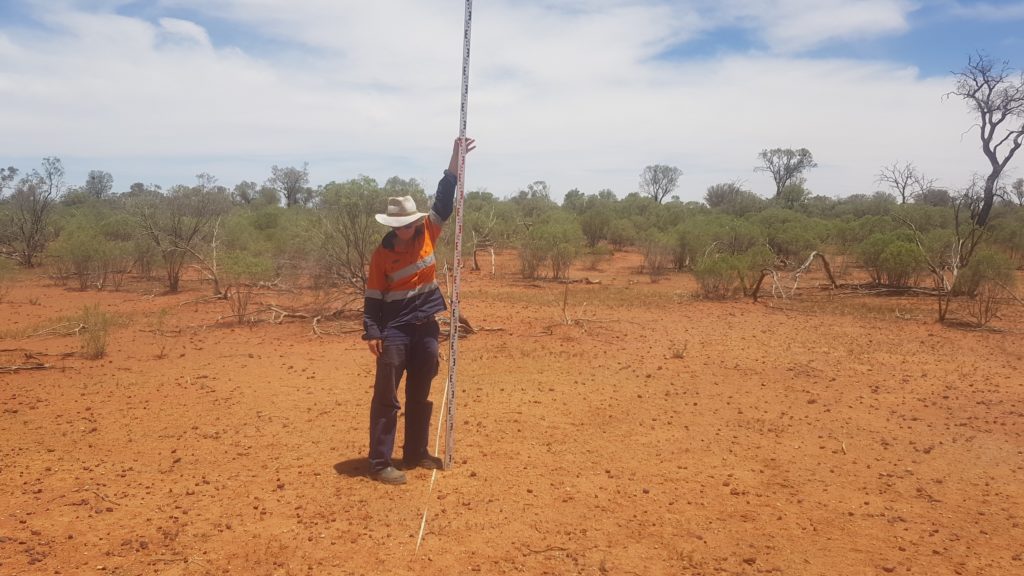Project Information
Darling River Conservation Initiative Site #9
Human Induced Regeneration
North-west of Louth in New South Wales, Glenora and King’s Bore sit on relatively flat terrain of soft, red, sandy soil. Across over 33,000ha the landscape ranges from open shrublands, interspersed with open cane grass swamp lands to ephemeral salt lakes.
Helen Parker is the leasehold owner of the two properties and decided to work with GreenCollar on a Human-Induced Regeneration project after seeing the broad scale impact of feral animals and domestic grazing on the native vegetation and wildlife.
Since implementing the project, Helen has invested back into the land and the local economy through fencing and watering point improvements, including upgrading boundary fencing and pipeline. Helen has also worked to remove feral goats from the properties – something that wouldn’t have been possible following the wool market crash if Helen didn’t have income from her carbon project.
Now, Helen runs a sustainable grazing enterprise while managing a mixed native forest of Bimblebox, Turpentine, Budda, Hopbush, Puntybush, Leopardwood, Mulga and Gidgee. Helen reports scrub and grass in the project area getting thicker and has seen grass-eating birds such as budgies and Mulga Parrots return as a result. The trees also provide refuge for many other species including the hooded robin as well as Corellas, Major Mitchell Parrots, Galahs and Sulphur Crested Cockatoos.
Helens’ favourite thing about the project? The regular sight of budgies swooping through the project area, the flock silhouetted against the red sunset.
Key Benefits
UN Sustainable
Development Goals

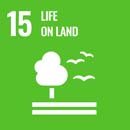
Statistics
Methodology
Human-Induced Regeneration of a Permanent Even-Aged Forest 1.1 methodology (2013)
Registered ID
Date registered
June 2019
Project area
24,599 ha
Permanence
100 years
Location
Louth, New South Wales
This project is located North West of Louth in NSW in the Mulga Lands bioregion. The land consists of soft sandy red soil interspersed with swamps and ephemeral salt lakes. The dominant species observed on the property from field surveys include Eremophila sturtii, Dodonaea viscosa, Senna artemisioides, Acacia aneura and Acacia cambagei.
The objective of this project is to regenerate natural woodlands and shrublands. This is achieved by controlled grazing and feral animal management across the project area including fencing upgrades and water management. In addition to sequestering carbon, regeneration of native vegetation in the project area reverses land degradation caused by feral goats and livestock and stabilises soils reducing erosion.
The Project (ERF132688) was declared project under the ‘Human Induced Regeneration of a Permanent Even-Aged Forest 1.1’ methodology (2013 c3) (the Determination) and generates Australian Carbon Credit Units (ACCUs). This is the fifth version of the Human Induced Regeneration methodology.
The project has issued Kyoto ACCUs in accordance with the date the carbon sequestration occurred. Kyoto ACCUs are issued for all carbon sequestration which has occurred after 14 May 2013 and non-Kyoto ACCUs are issued for carbon sequestration that occurred prior to this date.
| Methodology Determination | Human-Induced Regeneration of a Permanent Even-Aged Native Forest – 1.1 Methodology Determination 2013 c3 |
| Project Declaration Date [1] | 06 June 2019 |
| Permanence Period | 100 years |
| Baseline Period [2]
(10 year period before project commencement) |
May 2009 – May 2019 |
| Baseline management
(Management during the Baseline Period) |
Suppression of development of forest cover through uncontrolled livestock grazing, uncontrolled feral animal populations.
Confirmed by evidence. |
| Modelling Commencement Date [3]
(Date at which sufficient regeneration had started in the CEA) |
01 July 2012, 01 January 2013
Note: the method requires there to be some vegetation present, at the modelling commencement in order to confirm that the area has the capacity to regenerate. |
| Modelling Tool | FullCAM 2016 |
| Audit | There has been 1 audit undertaken by registered Greenhouse and Energy Auditors which have confirmed the project complies with the Methodology Determination and the requirements of the CFI Act in all material respects for the periods audited. The most recent audit report was issued on the 24 September 2020. |
HIR project Carbon Estimation Areas
What are Carbon Estimation Areas?
A CEA is an area of land within a project area where the project activity or activities are being carried out to sequester carbon (for example, the cessation of mechanical or chemical clearing or management of timing and extent of grazing to enable regeneration of vegetation to forest) and for which ACCUs can be credited[4].
These are the areas where project activities occur and where carbon abatement will be modelled applying standardised estimation formulae approved by the Clean Energy Regulator. There can be one or many CEAs on a Project Area.
Each CEA must contain areas of eligible land greater than 0.2ha in size in which the project activities are implemented and which have started to become native forest through regeneration.
- Eligible Land is land that didn’t have forest cover during the baseline period (ie. the 10 years before project commencement) and which has been used or managed in a way that suppresses development of forest cover.
- A particular area of land has Forest cover if the land has an area of at least 0.2 of a hectare and has trees that are 2 metres or more in height and provide crown cover of at least 20% of the land.
Stratification of Darling River Conservation Initiative – Site #9 HIR Project Area into CEAs
Stratification is the process of “demarcating the boundaries of CEAs from ineligible and non-implementation areas within a project area”[5].
There are Guidelines setting out how Project Areas are stratified into CEAs. These include rules about evidence, stratification and record keeping to support the requirements in the CFI Rule 2015 (2018 and 2019 Amendments) including key method eligibility requirements.
Stratification of the Darling River Conservation Initiative – Site #9 HIR Project was carried out in accordance with the Determination and first reported to the Clean Energy Regulator for a reporting period ending 30 June 2020.
A summary of the stratification of the Darling River Conservation Initiative – Site #9 HIR Project is set out below:
| Project Area | 35,640 hectares |
| Number of Carbon Estimation Areas (CEA) [7] | 105 |
| Total Carbon Estimation Areas (CEA)Size | 24,599 hectares |
| Total area excluded from CEA | 11,041 hectares |
| Excluded from CEA –
Pre-existing forest cover (forest present at any time during the baseline period) |
7,661 hectares |
| Excluded from CEA
No forest potential (areas of land that do not meet the requirements of forest potential) |
3,104 hectares |
| Excluded from CEA
Non-project area (areas of land that are within the project area but excluded for other reason e.g. infrastructure or areas excluded for production purposes) |
276 hectares |
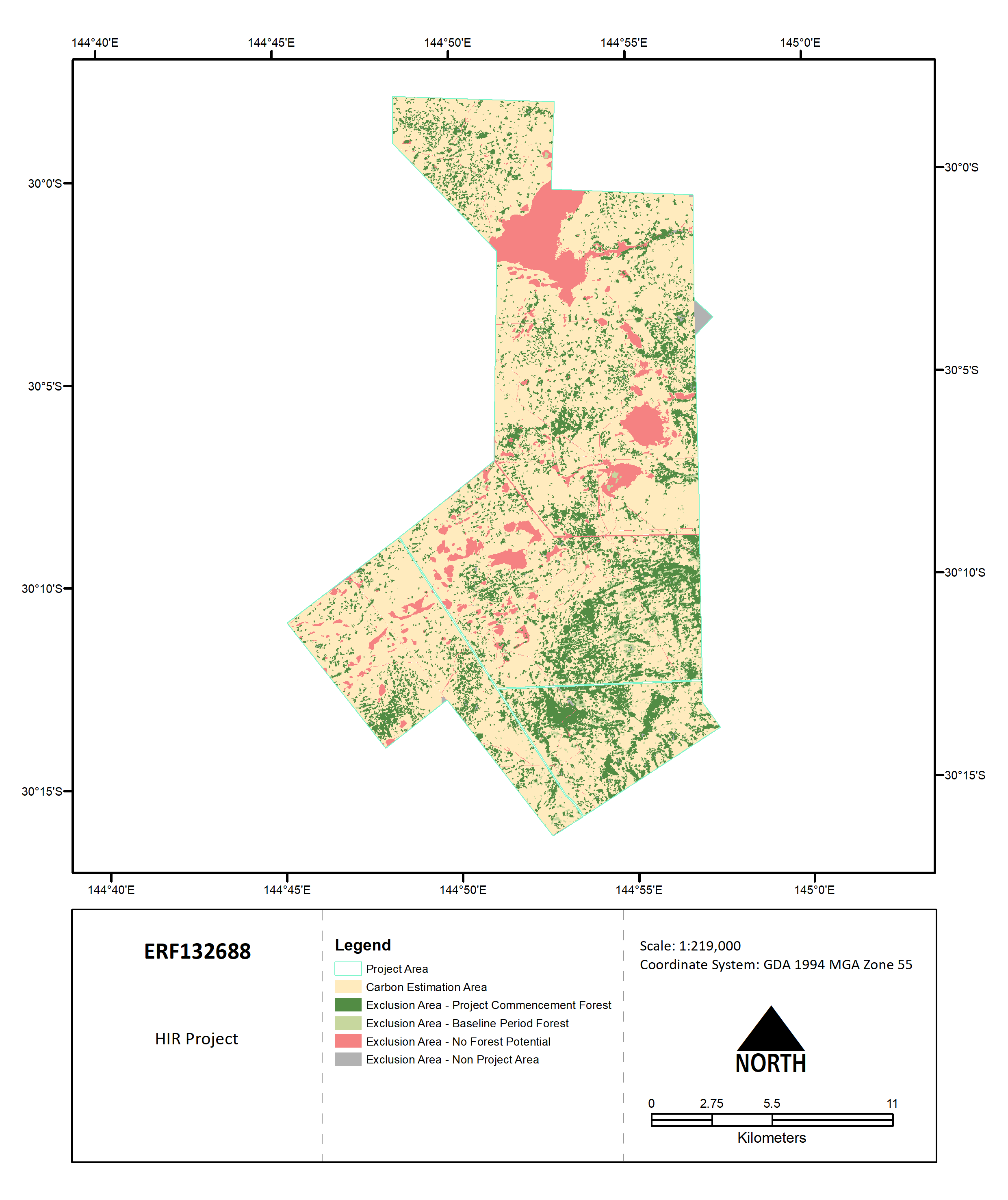
This map shows the project area boundary and the different elements of project design including the carbon estimation areas and exclusion areas. This stratification may reflect both initial stratification and subsequent revisions.
In order to validate the stratification of the Darling River Conservation Initiative Site #9 project in accordance with the Determination and Guidelines, GreenCollar carried out extensive field surveys and data collection. This included collection of data on existing vegetation species, stem density and vegetation height.

This map shows the points within the project area where ground truth surveys were conducted as part of the stratification process.
A Ground Truth Waypoint is a randomly allocated point within the project area where sampling data is collected.
The Guidelines also require a map accuracy assessment be completed before offset reporting. This assessment must include the field sample plots, which can be used in conjunction with remote sensing samples. The Clean Energy Regulator will accept mapping accuracies at or above 85 per cent for pre-existing forest and forest potential classification types. The overall accuracy of the Darling River Conservation Initiative Site #9 classification was 90.80% which is greater than the 85% minimum requirement of The Guidelines.
After the completion of the map accuracy assessment, any additional exclusion areas were delineated prior to finalising the initial stratification. The extent of exclusion areas (totalling 11,041 ha), comprised of pre-existing forest cover (7,661 ha) and areas which classified as having no forest potential (3,104 ha). Through this process a final eligible CEA area of 24,599 ha was confirmed.
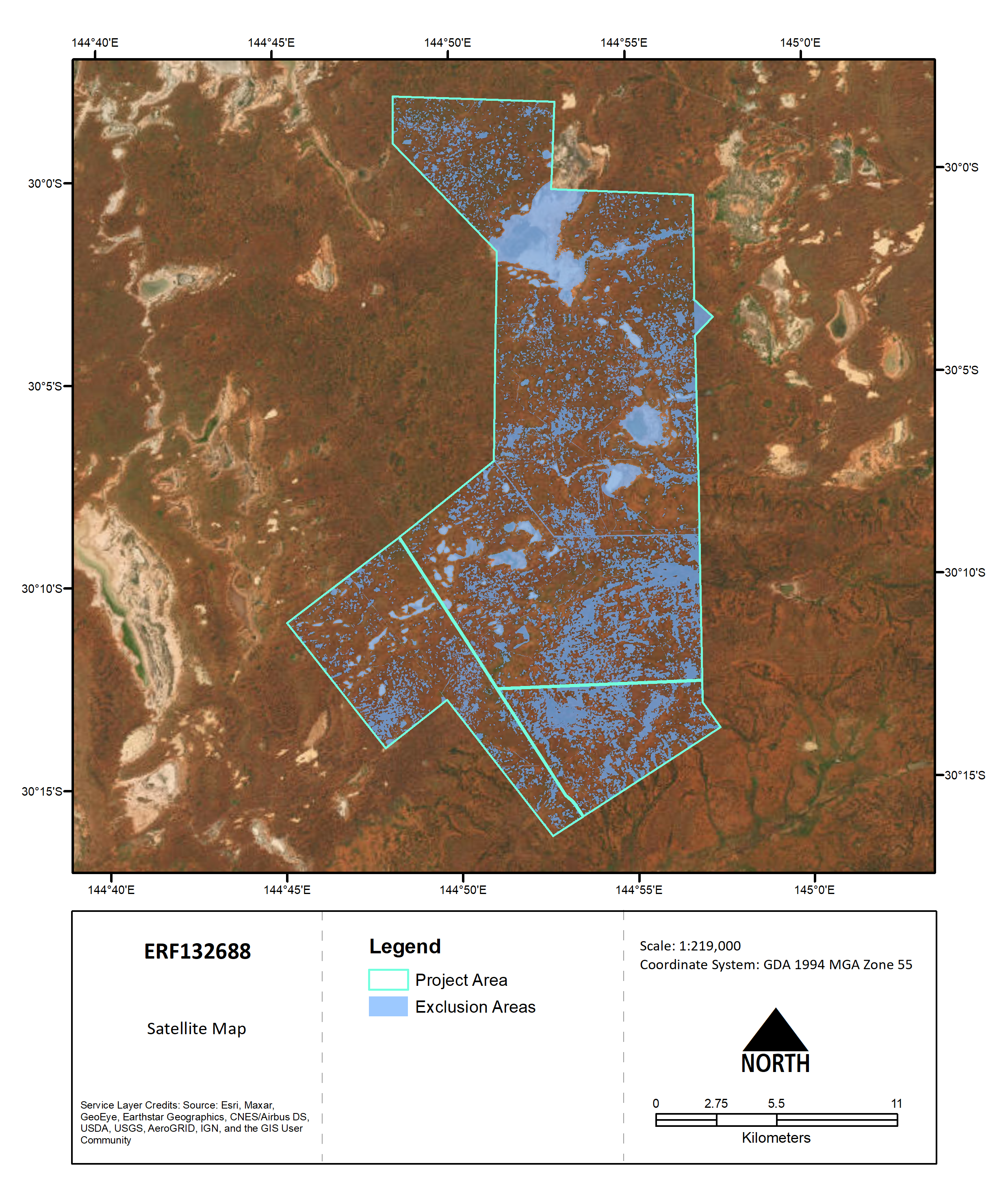
This maps shows a current satellite image of the project area. Satellite imagery and remote sensing datasets were used to identify eligible land and exclusion areas.
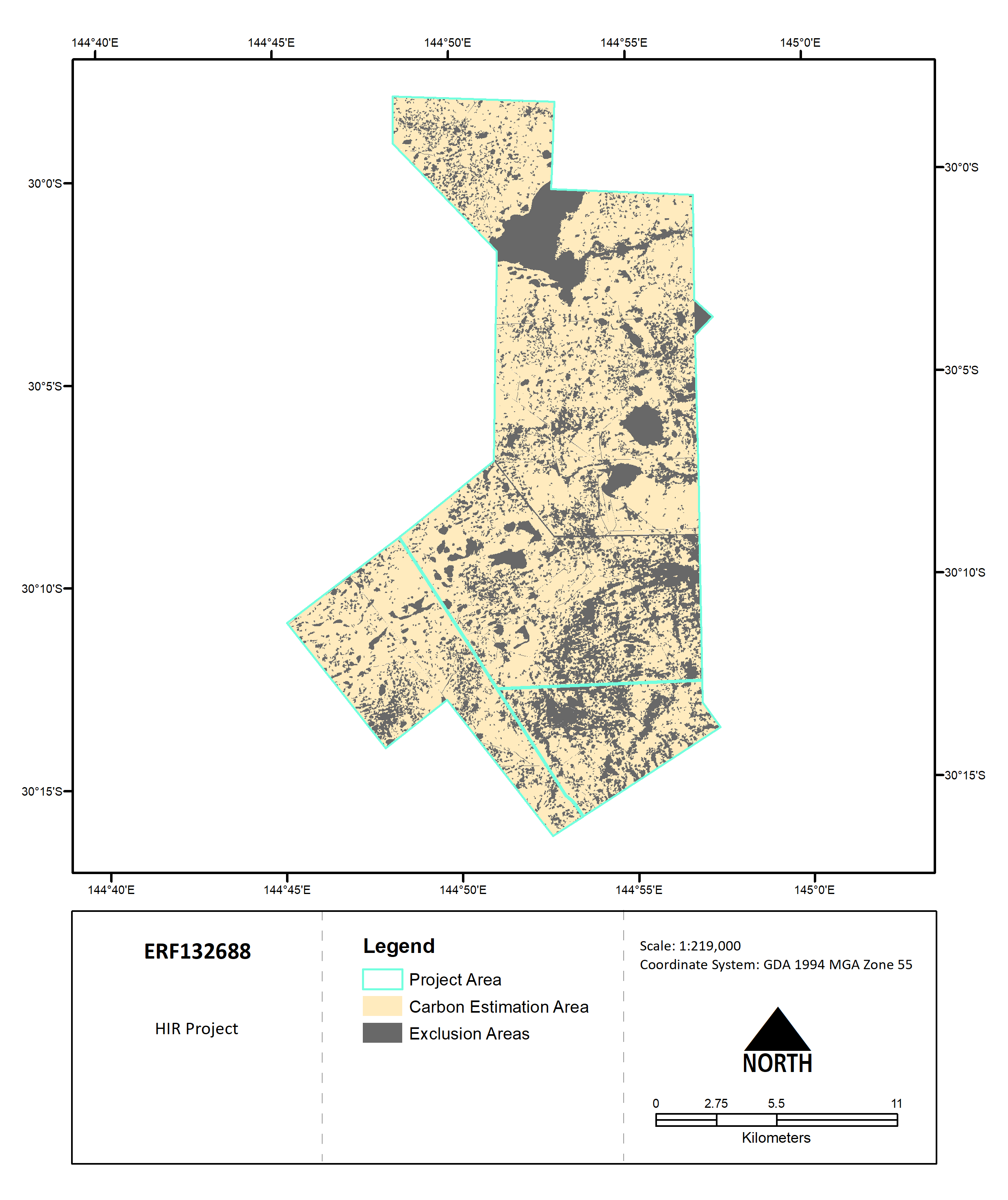
This map shows a summary of all CEA and Exclusion Areas.
Project Sequestration and Abatement
This version of the HIR Methodology requires using the Full Carbon Accounting Model (FullCAM) to determine the sequestration of carbon stocks and emissions required to calculate the net abatement amount for each reporting period. The carbon dioxide equivalent net abatement amount in relation to a reporting period for the project is taken to be the change in carbon stock for the project area less the project emissions. Any carbon stock that accumulated by the crediting start date for the project is calculated as the initial carbon stock and is removed from the calculation of abatement as the proponent is not entitled to credits for it.
See below for the average per hectare sequestration for the Darling River Conservation Initiative Site #9 HIR project.
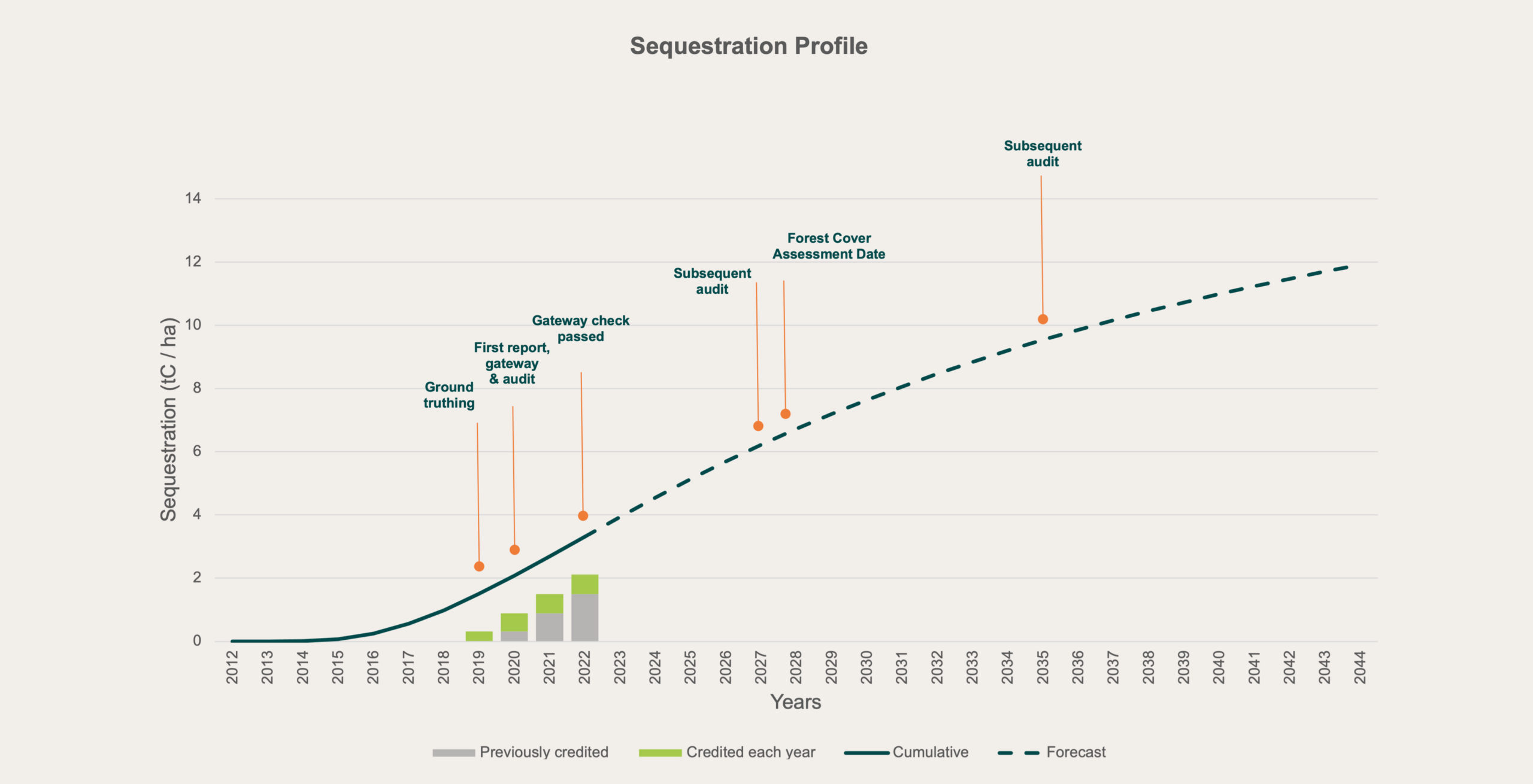
Implementation & Monitoring
The activities for the project are:
- the management of the timing & extent of grazing, and
- the management, in a humane way, of feral animals
Since project commencement these activities have been undertaken across the project area to assist the regeneration of native forest in attaining forest cover. Once the initial offsets report has been completed, GreenCollar works closely with the landholder of the project property to collect land management information every quarter. This is reviewed and reported on in each offsets report.
A summary of monitoring activities and evidence collection undertaken on this project is set out below:
- Evidence collection in relation to grazing and herd management
- Evidence collection in relation to removal and reduction of feral animals
- Evidence of fire management activities
- Evidence collection from landholder as to other land management activities as relevant
- Change detection assessments
- Repeat biomass inventory surveys to track biomass change of regenerating vegetation
- Daily fire hotspot monitoring and review of Seasonal Fire Risk
- Review of SPEI drought index
- Regeneration Gateway Checks
These surveys are currently not required under the HIR method but are implemented by GreenCollar to provide additional assurance that biophysical threats to carbon stores such as grazing, drought and fire are not negatively impacting the regeneration and to track progress of regeneration of the native forest. In addition, the data collected is utilised for broader research purposes.
Regeneration Checks
The Guidelines require that Proponents must provide regeneration checks at least once every five years from the start of the project’s last or only crediting period until CEAs pass their forest cover assessment date[6], and upon request by the Clean Energy Regulator.
A summary of regeneration checks required for the Darling River Conservation Initiative Site #9 HIR Project is set out below:
| Regeneration Check: Year 6
7.5% canopy cover at 100ha scale[7] |
01 July 2017, 01 January 2018 – Completed |
| Regeneration Check: Year 10
10% canopy cover at 10ha scale[8] |
01 July 2021, 01 January 2022 – Completed |
| Forest Cover Assessment Date [9] | 01 July 2027, 01 January 2028 |
The process and methodology includes one or more of the three evidence requirements and reporting:
- Evidence level 1: Change detection analysis, or
- Evidence level 2: Remote sensing analysis and/or
- Evidence level 3: Field data; and
- Reporting
Project Area Files
GIS shapefiles for the project can be downloaded here. These files detail the project stratification including the carbon estimation areas and exclusion areas.
[1] Carbon Credits (Carbon Farming Initiative) Act 2011 Section 27
[2] Carbon Credits (Carbon Farming Initiative) (Human-Induced Regeneration of a Permanent Even-Aged Native Forest—1.1) Methodology Determination 2013 c3 Section 4
[3] Carbon Credits (Carbon Farming Initiative) (Human-Induced Regeneration of a Permanent Even-Aged Native Forest—1.1) Methodology Determination 2013 c3 Section 28
[4] Guidelines on evidence, stratification and records 8 May 2019
[5] Guidelines on evidence, stratification and records 8 May 2019
[6] Forest cover assessment date has the same meaning as that given by section 9AA(6) of the CFI Rule.
[7] Guidelines on evidence, stratification and records 8 May 2019
[8] Guidelines on evidence, stratification and records 8 May 2019
[9] Carbon Credits (Carbon Farming Initiative) Rule 2015 Section 9AA(6)

